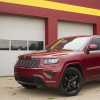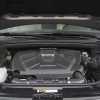The Jeep Grand Cherokee has been the shining star in Jeep’s lineup since its introduction back in 1993. It was the company’s vehicle to take on the world’s best. During its 20-or-so year life, it's had a mixed record on trying to accomplish this mission. But at the Detroit Auto Show this year, the off-road brand showed it meant business. Thanks to a reinvigorated Chrysler and a bit of help from Fiat, Jeep showed off a refreshed Grand Cherokee and made its intent very clear; we’re going to take on the world’s best. To see if the Grand Cherokee can handle this mission, I went back to back with two Grand Cherokees; an Altitude equipped with the 3.6L V6 and a Overland equipped with the new 3.0L EcoDiesel V6.
The Grand Cherokee’s shape hasn’t strayed far from the first-generation model shape. Sure the fourth-generation model has a few more angles and a new rear tailgate design, but park the current Grand Cherokee alongside the first-generation model and it's plain to see a family resemblance. From the iconic seven slot grille up front to the square-shaped rear-end, Jeep designers were able to make new Grand Cherokee stand out, but retain a bit of the DNA from the first-generation model.
Dependent on which trim level you go for, Jeep has made sure each one is different. The Grand Cherokee Altitude I got first follows the same treatment as the Cherokee Altitude a reviewed a few weeks back. There is a blacked-out grille and a set of twenty-inch wheels wearing a coat of black paint. Contrasting the red paint on my tester, I found myself really liking the looks of the Altitude. Then there is the Overland which adds a chrome grille, HID headlights, twenty-inch chrome wheels, and LED taillights. All of the changes make the Grand Cherokee Overland comparable to a Range Rover in looks.Inside the Grand Cherokee, Jeep has made some big changes. The interior now follows the ideals set by the Chrysler 300 and Dodge Charger with better materials used throughout the cabin, a screen placed in the middle of the instrument cluster to provide speed and trip computer information, an eight-inch touchscreen with UConnect, and the love it/hate it lever control for the automatic transmission. People sitting the rear seat will find a decent amount of leg and headroom.
Again, each trim level has their own take on interior treatment. The Altitude came with black-suede seats which I found to very comfortable and brushed faux-aluminum trim around the dashboard. Like the Cherokee Altitude, the Grand Cherokee Altitude comes with the UConnect system minus the navigation. The system is very easy to move around and navigate, plus you can get navigation from your local Chrysler dealer for a few hundred dollars extra. The Overland fills the Grand Cherokee with a number of luxury appointments such as leather seats with the Overland logo embroidered in the front, heated and ventilated front seats; wood trim, and a premium sound system. Stepping out of the Altitude and into the Overland, I was surprised how much the Grand Cherokee changed. From the sporty feeling I got from the Altitude to luxury in the Overland, I have to say Jeep really nailed making each trim level look and feel different from one another.
The Grand Cherokee Altitude came equipped with the 3.6L V6 producing 290 horsepower and 260 pound-feet of torque. This is paired to an eight-speed automatic transmission. I have written a lot about 3.6L in previous Chrysler vehicles, praising it for being one of the smoothest V6 engines on sale today and being able to move any vehicle with authority after reaching a certain point in the rev range. The story is very much the same in the Grand Cherokee as the V6 is able to move 4,545 pound vehicle with no problem at all. The eight-speed is smooth and provides smart shifts to keep the vehicle in motion. Fuel economy is rated at 17 City/24 Highway/19 Combined for the V6 equipped with four-wheel drive. My average landed around 22.1 MPG.
But the big story lies under the Overland. It came with the optional 3.0L EcoDiesel V6 with 240 horsepower and 420 pound-feet of torque. All of the torque is available at 2,000 rpm which means the Grand Cherokee EcoDiesel moves very swift. Whether leaving a stop-light, or making the run onto the expressway, the 3.0L EcoDiesel is able to provide the power when needed. The eight-speed automatic helps keep the diesel engine right in the sweet spot of torquey-goodness. The most surprising part of the EcoDiesel is NVH levels. Step outside the Grand Cherokee EcoDiesel when its idling and you can barely tell its running. The clatter usually associated with diesel engines is not apparent. On the fuel economy front, the Grand Cherokee EcoDiesel is rated at 21 City/28 Highway/24 Combined. I got an average of 24.2 MPG.As for suspension, the Altitude goes with a coil spring setup, while the Overland comes with an air suspension setup. The air suspension setup allows the Grand Cherokee to raise and lower its ride height to provide better aerodynamics out on the expressway and get through some of the roughest off-road trails. Both suspension setups provided excellent ride qualities on even some the roughest surfaces Metro Detroit had to offer. On the curvy bits, both suspensions kept the Grand Cherokee in check by minimizing body roll and lean. That doesn’t mean the Grand Cherokee is sporty as the weight of the vehicle puts that idea out to pasture. If you want sport, then you want the Grand Cherokee SRT.
It should be noted that I didn’t get the chance to take either Grand Cherokee off the beaten path. That is something I hope to change whenever I get another Grand Cherokee.
After spending two weeks and putting a number of miles on the Grand Cherokees, I came away very impressed. Jeep has built possibly one of the best all-rounders in the midsize class. Taking the 2011 Grand Cherokee redesign, Jeep made a number of changes that fix a number of problems of past Grand Cherokees. But those changes allowed Jeep to pull off a big feat with Grand Cherokee; the wide range of trims that make each one feel like they can take on a different part of the midsize SUV class. There’s the Altitude which provides a stylish alternative to those looking at crossovers, while the Overland gives a formidable challenge to the likes of the Mercedes-Benz ML, BMW X5, and Land Rover LR4.
The 2014 Jeep Grand Cherokee sets a new bar for excellence in the SUV class.
Disclaimer: Jeep Provided the Grand Cherokees, Insurance, and One Tank of Gas and Diesel
Year: 2014
Make: Jeep
Model: Grand Cherokee
Trim: Altitude 4X4
Engine: 3.6L 24-Valve VVT V6
Driveline: Eight-Speed Automatic, Four-Wheel Drive
Horsepower @ RPM: 290 @ 6,400
Torque @ RPM: 260 @ 4,800
Fuel Economy: City/Highway/Combined - 17/24/19
Curb Weight: 4,677 lbs
Location of Manufacture: Detroit, Michigan
Base Price: $31,195
As Tested Price: $38,485 (Includes $995.00 Destination Charge)
Options:
Customer Preferred Package 23Z - $5,100
Power Sunroof - $995.00
Year: 2014
Make: Jeep
Model: Grand Cherokee
Trim: Overland 4X4
Engine: 3.0L DOHC Diesel V6
Driveline: Eight-Speed Automatic, Four-Wheel Drive
Horsepower @ RPM: 240 @ 3,600
Torque @ RPM: 420 @ 2,000
Fuel Economy: City/Highway/Combined - 21/28/24
Curb Weight: 5,393 lbs
Location of Manufacture: Detroit, Michigan
Base Price: $46,195
As Tested Price: $55,680 (Includes $995.00 Destination Charge)
Options:
3.0L EcoDiesel V6 - $4,500
Advance Technology Group - $1,995
Rear Blu-Ray Entertainment System - $1,995







-3707742431.jpg.06edf8e14f4ccf35c60d4774a543cc11.jpg)



Recommended Comments
Join the conversation
You can post now and register later. If you have an account, sign in now to post with your account.
Note: Your post will require moderator approval before it will be visible.